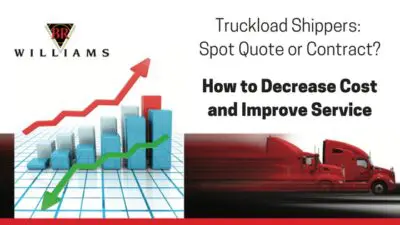
See the Current Trucking Industry Report Here »
2017-2018 Report
A Preface (from our CEO)
Hello,
I have traveled some in the last year to national meetings discussing various transportation and economic content. As a result, I have become increasingly focused on what is developing in the supply chain and trucking industry, across the nation.
Personally, I have been in trucking for some 34 years. Entering into the industry shortly after it was deregulated in 1980, I saw dramatic change in the following five years. Since then, three monumental events have taken place, in 1994, 2003, and most recently in 2014.
The most drastic of the events occurred in 1994, when the economy was hot with an unemployment rate of 5.4% and the Trucking Industry Regulatory Reform Act (TIRRA) was passed. This law finally completed the deregulation that had started in 1980; by removing the requirement for all trucking companies (except household goods carriers) to file their individual interstate common carrier tariffs, the tariffs filed with the ICC became null and void.
The industry was changing dramatically, as new laws sparked an era of competition, truck capacity rose to an all-time stretch, and truck drivers at 22 large companies went on strike (for the longest period, at the time). It seemed to be an era of combined forces, marking an unusual and unprecedented time for a trucking company.
To veterans in the industry, conditions are forming today that feel very similar to 1994. This write up will address these conditions and implications.
Thank You,
Greg Brown, CEO
Logistics & Trucking Company Industry Report (2017-2018)
The Truck Driver Shortage
In 2015 the driver shortage skyrocketed, with 45,000 drivers needed in the truckload sector.
In 2016, freight volumes softened somewhat, allowing this shortage to fall back to 36,000 truck drivers needed.
However, with current conditions, driver shortages in this sector are expected to increase to an unprecedented 50,000 drivers needed. That is an alarming 70.6% of all freight tonnage moved on our nation’s highways.
There are several factors combining to create this scenario, including demographics, lifestyle, job alternatives, laws & regulations, technology, high turnover rates, etc.
Demographics
The median age of an over-the-road (OTR) truck driver is 49. The average age of the American worker is just 42. This is a drastic difference, and unfortunately the current driving force dramatically aging and retiring is higher than that of incoming truck drivers.
The minimum age to work for a trucking company is 21 years old. Most individuals, if they are not on the college track, have already made a career choice and working by age 21. This requirement restricts the availability of young people interested in becoming involved with a trucking company.
While age plays an important role, so does gender. Women make up nearly 47% of all U.S. workers, yet only 6% of all truck drivers are female, according to the U.S. Department of Labor. This demographic has only varied from a low of 4.5% to a high of 6% since 2000. This number restricts job growth, as companies thrive when both men and women participate at high levels.
Lifestyle
As older drivers make the decision to slow down or retire, younger inexperienced drivers are assigned to longer less popular routes. Most times, these individuals are newly married, and are attempting to or have recently started a family.
Young individuals who do decide to make a career out of driving for a trucking company are seen moving to regional or local driving positions as soon as they gain more experience and seniority.
Job Alternatives
During the recession seen from 2008-2012, the trucking industry was one of the few industries consistently hiring people. Today, with an unemployment rate of only 4.1% (in 2017), job market improvement has created more options for individuals.
For example, the construction industry alone has increased by 1.3 million workers in the last five years. This is because, construction jobs are local, have less responsibility and fewer regulatory guidelines to follow.
Laws and Regulations
A trucking company has to enforce many regulations directly placed on the truck driver. From hours of service regulations to the recently mandated ELD requirements, many choose to not deal with the hassle of these regulations and search for other available job options.
For example: The ELD mandate is a regulation effective December 18, 2017, that requires all for-hire and private trucking fleets to have switched from paper logs to “ELDs” (Electronic Logging Devices). It faced such backlash from truck drivers and trucking company executives, industry-wide, that many assumed the ELD mandate would either be delayed, see revisions, or get dismissed entirely.
However, as it becomes increasingly obvious that the ELD mandate will remain in place without revisions, a large part of the industry is in a quandary. The American Trucking Association estimates that there are 3.5 million truck drivers in the U.S. and upwards of 1 million trucks without the required devices.
This puts the trucking industry in a precarious situation, as it is yet undetermined whether regulators will enforce requirements with a soft hand or hard enforcement. In addition to some fleets facing undetermined fates as a result of non-compliance on December 18, it will take some time to determine what effect this regulation will have on the productivity of fleets.
The repercussions a trucking company may face will have to be sorted out over the next six to nine months, but the chart below projects what loss of productivity could look like once ELD’s are completely adopted.
Technology
There is technology on the horizon that could provide some relief to our industry in the future, however, it will not be available in entirety for several more years.
Truck “Platooning” and Smart or Autonomous Trucks are currently in development and testing fazes. Unfortunately, none of these are expected to be available industry-wide in the upcoming years.
High Turnover Rates
Turnover rates in the for-hire truckload sector have soared since the economic recovery of 2008, experiencing at least 90% turnover between 2012 and 2015.
While the turnover rate dropped to 81% in 2016, as freight volumes softened, current 2017 data indicates the turnover rate for this year will again exceed 90%, due to industry churn.
Current Trucking Industry Trends
As a result of these and other factors, truck capacity is becoming increasingly difficult to source, spot market rates are sky-rocketing, service failures are mounting, and shippers are feeling the pinch.
To varying degrees, some shippers with dedicated capacity and contract rates are protected from this instability. However, contract rates, in the long term, tend to follow spot market rates. With bid season approaching, every trucking company, shipper, broker, and carrier will be affected by these conditions. In order to address this problem head-on, we must better understand where we are headed.
Capacity Utilization in the Trucking Industry
Capacity Utilization has increased from 90% in 2000 to approximately 98% in 2017. While this is indeed good for the environment and the industry, an aiding effect has been to remove “flex” from the market. Meaning, a trucking company experiences very little margin for error.
Truck tonnage can increase or decrease rapidly, but it takes time for trucks, trailers and drivers to be added to the market to accommodate increases in demand. Without the “spare” capacity represented in capacity under-utilization, any significant increase in demand will cause trucking company shortages.

Capacity Utilization and the ELD Mandate
Capacity is not a truck and trailer. It is not even a truck, trailer and driver. Capacity is a truck, trailer, and a driver with legal hours to drive. As such, the ELD mandate (as discussed previously), which has been gradually implemented over the last several months, has effectively removed capacity from the marketplace.
Not only does the reduced capacity increase pressure on trucking company rates, the carrier loses driver productivity, and the drivers (paid exclusively by virtue of their productivity) are taking home less money. The carriers must then reciprocate the drivers’ lost wages, as well as their own lost productivity yield.
None of these factors would cause the current conditions if this were 2009 and demand for a trucking company was plummeting. On the contrary, demand for a trucking company is increasing rapidly. While this is, in part, due to Hurricanes Harvey and Irma, it is not the only source of the increase in trucking company demand as economic conditions continue to improve across all business sectors.
The Future of the Logistics & Trucking Industry
With the large number retiring drivers and slow growth of entry-level candidates in search of a trucking company job, the driver shortage is expected to increase again in 2018 to over 63,000 needed drivers.
If the trucking industry experiences no change or new regulation, the trend line is expected to continue at the same pace, resulting in a shortfall of 175,000 drivers in 2026 or before.

In order to better understand what a trucking company might expect in the future, it’s important to consider the contributing factors that have resulted in the current market conditions.
At any given time, the various factors that affect the degree to which truck capacity supply is meeting demand can, and often do, point in different directions. When this is the case, trucking company capacity and rates are stable. When these factors are all exerting the same type of pressure, trucking company capacity can tighten or loosen rapidly. As it has occurred in 2017 and will continue to occur through 2018, these factors are aligned in a perfect storm scenario that will prove to be very challenging for shippers and brokers.

As the cost of operating a trucking company has increased, carriers have passed along these costs to shippers. In return, shippers have encouraged carriers to find ways of becoming more efficient. Carriers have indeed responded to this, by trimming so much off of the process that any more could begin to affect the product itself.
Conclusion
Our trucking company has experienced conditions similar to these before (tight labor market, driver shortages, pending regulations) in 1994, 2003 and 2014. These factors more closely resemble 1994 and 2003, which included harsh market conditions that did not improve for one and one-half to two years.
The market will indeed stabilize again, but given the predictive data, BR Williams believes that we are months away from stability, and far longer from achieving trucking company supply/demand equilibrium. However, with tax reform in the works, it’s impossible to predict the extremes a trucking company could expect.
A few recommendations when preparing for 2018:
- Find ways to provide more advance notice. This increases the likelihood that your asset-based carriers will have availability and increases the likelihood that your 3PL’s will be successful in sourcing affordable capacity.
- Avoid expedites like the plague. Expedited capacity is being consumed by the standard service market (at expedited rates). If you are able to source an expedited carrier, which is questionable, the rates have never been higher, and being selective with service providers is usually not an option.
- Ask how your 3PL sources capacity and the characteristics of their typical carrier? If your 3PL specializes in cheap trucks, there is a very good chance that they operate almost entirely on the spot market, which renders their shipper customers far more vulnerable to the spot market than a 3PL that specializes in higher quality capacity (established, safe carriers). Ask them how
- Lock in capacity and contract rates for 2018 with a preference for asset-based carriers. The spot market will continue to worsen through 2018. Those shippers that are operating primarily within the spot market are the most vulnerable in the shipping community.
See the 2018-2019 Trucking Industry Report Here »
About BR Williams Trucking & Logistics
BR Williams, a family-owned Trucking, Warehousing, Fulfillment & Logistics Company has been serving customers since 1958. We specialize in removing the supply chain frustrations our customers have by developing custom-made solutions. We offer nationwide transportation services through our fleet and logistics division. Our multiple fulfillment and distribution warehouses in Alabama span over 1.7 million square feet. Our core values are HONESTY, INTEGRITY, SERVICE. We still serve our first customer that was established in 1958.
To discuss your supply chain needs, please contact us online or call (800) 523-7963







